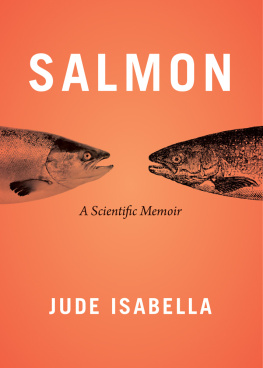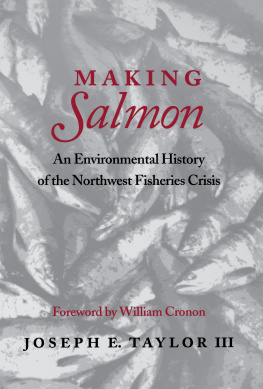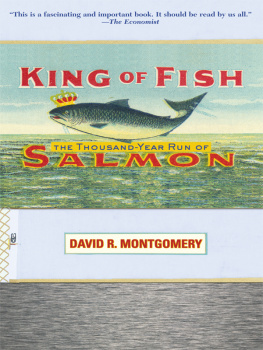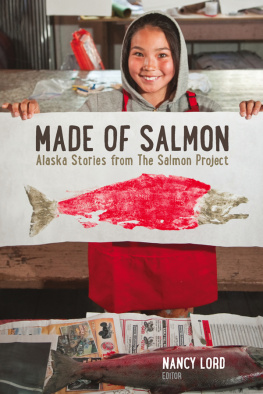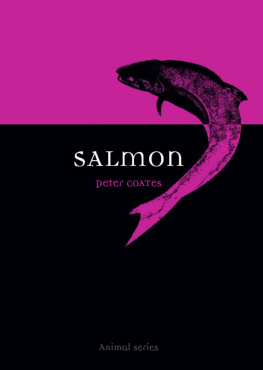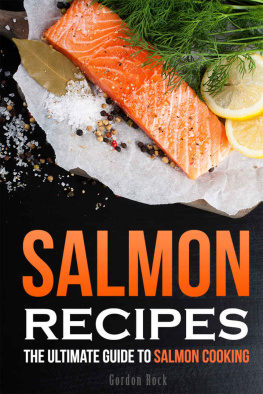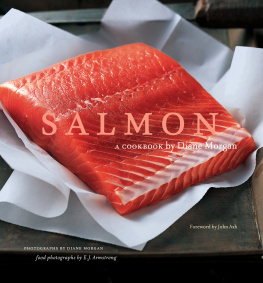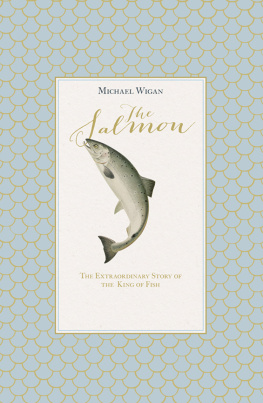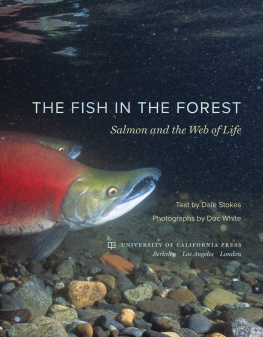ACKNOWLEDGEMENTS
My deep gratitude and thanks go to the First Nations who welcomed me to their territories: the Heiltsuk, St:l, Stsailes, Tlaamin, and the Kwiakah, Xwemalhkwu and Wei Wai Kum (the Laich-Kwil-Tach Treaty Society). I want to thank Tyrone McNeil of the St:l Tribal Council and his family for welcoming me to the familys dry rack fishery though not in the book, their hard work and knowledge set the tone of the story. There were also the scientists and knowledge holders who welcomed me into the field, lab and/or answered all manner of questions: Will Atlas, Megan Caldwell, Tim Clark, Dee Cullon, Brooke Davis, Randy Dingwall, Erika Eliason, Amy Groesbeck, Scott Hinch, Yeongha Jung, Dana Lepofsky, Quentin Mackie, Iain McKechnie, Duncan McLaren, Rhy McMillan, R.G. Matson, Heather Pratt, John Reynolds, Christine Roberts, Anne Salomon, Carol Schmitt, Mary Thiess, Brian Thom, Marc Trudel, Michelle Washington, Louie Wilson and Elroy White. Eric Peterson, Christina Munck and the Hakai Beach Institute hosted me and unknowingly provided me with access to some of the final threads of the story. I would like to thank David Beers at The Tyee, who said yes far more often than no; the Society of Environmental Journalists for travel funding; the University of Victorias anthropology department for providing funding, an academic home and proudly claiming me as one of their own; and the captain and crew of the CCGS W.E. Ricker. April Nowell and David Leach provided support, encouragement, comments and good-natured pressure to get the manuscript done already. I especially want to thank the ever-patient Tobin Stokes for answering frantic phone calls from a lost traveller and giving really good directions, and for packing a house and moving almost single-handedly, sometimes with only a bicycle as transportation. Finally, I want to thank my editor Margaret Knox, whose voice I now hear in my head every time I write (thank you, Meg).
JUDE ISABELLA has been a journalist for over 20 years, focusing on science, health and the environment. She writes for a diverse audience, from grownups interested in archaeology to young readers curious about space exploration. Jude has written five science books for kids, including Fantastic Feats and Failures, which won the prestigious American Institute of Physics Award. She spent three years researching salmon and marine biodiversity on Canadas West Coast, resulting in this book. Jude lives in Victoria, British Columbia.
BIBLIOGRAPHY
Agriculture and Agri-food Canada. Canadian Salmon: The Emperor of Fish. 2011. http://publications.gc.ca/site/eng/440267/publication.html.
American Association for the Advancement of Science. Bright Beaks Provide Honest Look at Male Immune System, Science Study Says. April 3, 2003. http://www.eurekalert.org/pub_releases/2003-04/aaft-bbp032803.php.
Ames, J., and S. Schroder. Chum Salmon Colors. Washington Department of Fish and Wildlife. Last modified 2014. http://wdfw.wa.gov/fishing/salmon/chum/chum_colors.html.
Araki, H., B.A. Berejikian, M.J. Ford, and M.S. Blouin. Fitness of HatcheryReared Salmonids in the Wild. Evolutionary Applications 1, no. 2 (2008): 342355.
Asche, Frank, Hvard Hansen, Ragnar Tveteras, and Sigbjrn Tveters. The Salmon Disease Crisis in Chile. Marine Resource Economics 24, no. 4 (2009): 405411.
Atran, S. Anthropogenic Vegetation: A Garden Experiment in the Maya Lowlands. In The Lowland Maya Area: Three Millennia at the Human-Wildland Interface, edited by A. Gomez Pompa, M.F. Allen, S.L. Fedick, and J.J. Jimnez-Osornio, 517532. Boca Raton, FL : CRC Press, 2003.
Atran, S. Taxonomic Ranks, Generic Species, and Core Memes. Behavioral and Brain Sciences 21, no. 4 (1998): 593604.
Atran, S., and D. Medin. The Native Mind and the Cultural Construction of Nature. Boston, MA : MIT Press, 2008.
Atran, S., D. Medin, and N. Ross. The Cultural Mind: Environmental Decision Making and Cultural Modeling Within and Across Populations. Psychological Review 112, no. 4 (2005): 744776.
Atran, S., D.L. Medin, and N.O. Ross. Evolution and Devolution of Knowledge: A Tale of Two Biologies. Journal of the Royal Anthropological Institute 10, no. 2 (2004): 395420.
Avery, G. Discussion on the Age and Use of Tidal Fish-Traps (visvywers). The South African Archaeological Bulletin 30, (1975): 105113.
Barnett, H.G. The Coast Salish of Canada. American Anthropologist 40, no. 1 (1938): 118141.
Barnett, Homer. The Nature and Function of the Potlatch. PhD diss., University of Oregon, 1938.
BC Pacific Salmon Forum. Final Report and Recommendations to the Government of British Columbia, January 2009. http://www.marineharvestcanada.com/documents/BCPSFFinRptqSm.pdf
Beacham, T.D., B. McIntosh, C. MacConnachie, K.M. Miller, R.E. Withler, and N.V. Varnavskaya. Pacific Rim Population Structure of Sockeye Salmon as Determined from Microsatellite Analysis. Transactions of the American Fisheries Society 135, no. 1 (2006): 174187.
Beacham, T.D., J.R. Candy, K.D. Le, and M. Wetklo. Population Structure of Chum Salmon (Oncorhynchus keta) across the Pacific Rim, Determined from Microsatellite Analysis. Fishery Bulletin 107, no. 2 (2009): 244260.
Beacham, T.D., K.L. Jonsen, J. Supernault, M. Wetklo, L. Deng, and N. Varnavskaya. Pacific Rim Population Structure of Chinook Salmon as Determined from Microsatellite Analysis. Transactions of the American Fisheries Society 135, no. 6 (2006): 16041621.
Beall, Cynthia M. Andean, Tibetan, and Ethiopian Patterns of Adaptation to High-Altitude Hypoxia. Integrative and Comparative Biology 46, no. 1 (2006): 1824.
Beall, Cynthia M., Michael Decker, Gary M. Brittenham, Irving Kushner, Amha Gebremedhin, Kingman P. Strohl. An Ethiopian Pattern of Human Adaptation to High-Altitude Hypoxia. Proceedings of the National Academy of Sciences of the United States of America 99, no. 26 (2002): 1721517218.
van den Berghe, E.P., and M.R. Gross. Female Size and Nest Depth in Coho Salmon (Oncorhynchus kisutch). Canadian Journal of Fisheries and Aquatic Sciences 41, no. 1 (1984): 204206.
Blount, Jonathan D., Neil B. Metcalfe, Kathryn E. Arnold, Peter F. Surai, Godefroy L. Devevey, and Pat Monaghan. Neonatal Nutrition, Adult Antioxidant Defences and Sexual Attractiveness in Zebra Finch. Proceedings of the Royal Society B: Biological Sciences 270 (2003): 16911696.
Boas, Franz. Indian Myths & Legends from the North Pacific Coast of America. Edited by Randy Bouchard and Dorothy Kennedy. Translated by Dietrich Bertz. Vancouver, BC : Talonbooks, 2002.
Braun, D.R., J.W. Harris, N.E. Levin, J.T. McCoy, A.I. Herries, M.K. Bamford, L.C. Bishop, B.G. Richmond, and M. Kibunjia. Early Hominin Diet Included Diverse Terrestrial and Aquatic Animals 1.95 Ma in East Turkana, Kenya. Proceedings of the National Academy of Sciences 107, no. 22 (2010): 1000210007.
British Library. Treasures in Full Magna Carta. Accessed May 15, 2014. http://www.bl.uk/treasures/magnacarta/translation/mc_trans.html.
Butler, V.L., and S.K. Campbell. Resource Intensification and Resource Depression in the Pacific Northwest of North America: A Zooarchaeological Review. Journal of World Prehistory 18, no. 4 (2004): 327405.
Caldwell, M. Fish Traps and Shell Middens at Comox Harbour, British Columbia. In The Archaeology of North Pacific Fisheries, edited by Madonna L. Moss and Aubrey Cannon, 235245. Fairbanks: University of Alaska Press, 2011.
Caldwell, M. A View from the Shore: Interpreting Fish Trap Use in Comox Harbour through Zooarchaeological Analysis of Fish Remains from the Qumu?xs Village Site (DkSf-19), Comox Harbour, British Columbia. MA thesis, University of Manitoba, 2008.

